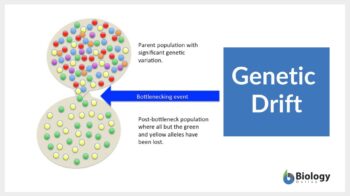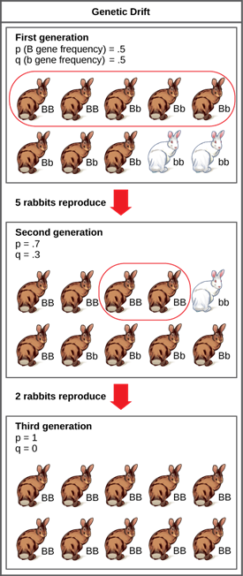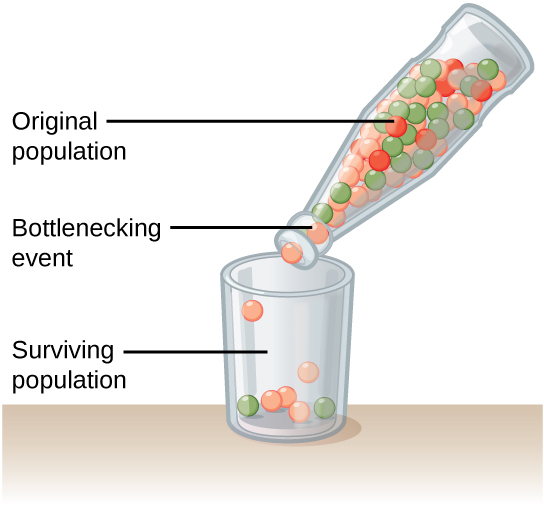
Genetic drift
n.,
the process of change in the frequency of an allele (gene variant) in a population over time.
Credit: Tsaneda, CC BY 3.0.
Table of Contents
Genetic Drift Definition
What is genetic drift in simple terms? The simple definition of genetic drift ( also referred to as Sewall Wright effect or allelic drift ) is a method of changing the population’s frequency of an allele by chance where some individuals with specific allele reproduce more than the others, this process may result in the loss of beneficial alleles or allele fixation of harmful alleles since the gene frequency changes by chance and not because it is a beneficial allele such as the natural selection theory.
Genetic drift contributes to the natural evolution of species, it may lead to the fixation of new alleles that have been recessively fixed in the previous individuals and the development of a new feature in the population. Genetic drifting occurs in all species; however, it is much more significant in small populations in which the number of individuals has been reduced due to a natural disaster (bottleneck effect) or when a number of individuals separate from their population to form a new colony (founder effect).
Is genetic drift random? In fact, genetic drift is random as it occurs as a result of pure chance, however, it affects small populations significantly unlike large populations that are not susceptible to change due to chance. For example, if a population of 5 members lost 1 member due to chance without leaving any offspring, the population would lose 1/5 of their genetic pool which represents 20 percent of the population’s genes. Alternatively, if one member is lost from a 50-member population, the lost genes would represent 1/50 of their genetic pool which represents only 2 percent of the overall population’s genes. Therefore, large populations are not greatly affected by the impact of genetic drift.
Unlike natural selection, genetic drift outcomes are unpredictable, it is like flipping a coin without knowing which face you will get, gene drifting outcomes are always due to pure chance.
Genetic drift is the drifting of the frequency of an allele relative to that of the other alleles in a population over time as a result of a chance or random event. An example where the effect of genetic drift is magnified is the so-called bottleneck effect. Synonyms: allelic drift; Sewall Wright effect.
Genetic Drift Examples

Genetic drift, gene flow, mutations, and natural selection are responsible for the change in the gene pool over time. Example of genetic drift: a population of rabbits with alleles B and b, both alleles are present in equal frequencies p = 0.5 and q = 0.5 if 10 parents reproduce the probability of having an offspring with alleles B or b is 0.5; however, by chance, a slight difference in the offspring allele frequency might occur due to random sampling. As a result, in the next generation, the allele frequencies will change slightly to new frequencies by chance to become p = 0.4 and q = 0.6. in the following generations, the random sampling of alleles continues and the change in allele frequency will be greatly different from the initial 0.5 frequency due to genetic drift. Even though genetic drifting is one of the factors that participate in the evolutionary process of the genetic pool by increasing or decreasing a certain allele’s frequency, however, it does not influence the adaptation of individuals to the environment since the affected genes may be harmful or beneficial genes.
What causes genetic drift?
Even though genetic drift is the result of chance, however, if you need to define genetic drift outcomes you should know how it is affected by many factors such as the number of individuals within the population, where the effect of genetic drift is more predominant in small populations, the second factor is the number of individuals contributing in genetic drifting since some individuals do not produce offspring. Another factor is the occurrence of natural disasters that affects the population size; accordingly, these disasters will increase the significance of random genetic drift among the population as well as the change in natural gene flow patterns. Habitat fragmentation is one of the main factors that influence gene drifting where humans live in nonurban habitats so nonhuman populations are dispersed or even eliminated. As a result, gene flow among these populations is decreased while gene drifting becomes more significant.
Humans can change the effect of gene drifting where they can move individuals to new environments voluntarily or accidentally due to urbanization, urbanization affects the less-mobile species to an extent more than mobile species by increasing the rate of gene flow among these species. The gene flow facilitated by humans is usually known as “Human-facilitated gene flow” it may also introduce new genes into the population allowing for new alleles and mutations. Dispersion of populations due to urbanization may decrease the influence of genetic drift since the bottleneck effect will decrease.
Genetic Drift Consequences
What is the role of Genetic drift in evolution? Genetic results in loss of diversity in the genetic pool where fixation of certain genes may be similar to its initial frequency in the population. Another consequence of genetic drifting is the increase in differentiation among populations where different the population of the same species may have different alleles due to genetic drifting, this occurs if the frequency of one allele is fixed in a population, while its frequency decreases in another population since the frequencies of alleles in the genetic pool proceed in different directions.
Sampling error can cause more changes in small populations’ allele frequencies than the large ones. In small populations, alleles are fixed more rapidly than large populations since the gene pool of large populations tends to be more stable. However, Large populations are affected by genetic drift since they become small as a result of a natural disaster that decreases the population size greatly until the conditions improve to allow the regrowth of the population (bottleneck effect) or when a small population leaves the group to establish a new colony when the population is threatened (founder effect). In order to protect a small population from extinction, genetic diversity should be maintained, consequently, genetic drift should be minimized and mutation should be maintained to facilitate adaptation.
Types of Genetic Drift
The genetic drift effect does not depend on the benefits of an allele, since a harmful allele may be fixed and a beneficial allele may be lost by chance. Regardless of their effect, rare recessive genes can become more common by the effect of genetic drift when the population is exposed to a natural disaster (bottleneck effect) or when a group of individuals separates from a population (founder effect) where the effect of genetic drift appears greatly in small populations. In more detail, we are discussing the bottleneck effect vs founder effect:
Population bottleneck

What is the Bottleneck Effect? The bottleneck effect definition is the decrease in the number of individuals in a population due to a natural disaster, genetic drift bottleneck effect usually influences the genetic distribution among the population, therefore, the effect of genetic drift becomes more significant. Consequently, the genetic variation among this population will decrease as the number of mating individuals will decrease.
When genetic drift rate increases in a population this leads to the loss or the fixation of some alleles, this phenomenon is described in terms of a decrease in the genetic effective size. Even though populations experiencing a bottleneck may reproduce and become larger in size again, however, the genetic variation among these populations declines at a rate that represents the size of the disaster until new individuals are introduced into the population through migration or when new mutations occur. The bottleneck biology strength is affected by its size and duration, these factors are calculated mathematically to determine the influence of the bottleneck on the population’s genetic variation.
Founder effect
The founder effect definition in biology is when a small population may be formed due to the founder effect when a small number of individuals leave their population to start a new colony, these individuals do not necessarily cover the whole genetic set of the population; therefore, gene drifting effect is significant within this small population. An example of the founder effect is most commonly found among species of fungi where the spores disperse and colonize in different environments forming new colonies that may not have the same alleles as the population from which they were originated.
Genetic Drift vs Gene Flow
Gene flow is the flow of alleles from one generation to another by means of migration or dispersion, some populations do not usually experience migration or dispersion while others are more flexible, for example, plants and fungi send their pollens or spores away from their population to colonize in different environments. Even though some populations may seem stable, however, they are not as stable as they seem, such as lions that leave their mothers after development to search for a female that is not related to their population. This flow of genes among populations contributes to the change of the gene pool of every population as well as the introduction of new genes to continue the evolutionary process.
Gene drift is counteracted by gene flow since a population does not usually stay small for a long time to be influenced by genetic drift. However, gene flow can counteract the effect of genetic drift only if the population’s gene flow is sufficient to increase the frequency of alleles lost by gene drifting. Gene flow may occur as a result of passive seed dispersal or active migration, studies have shown that only one migrant per generation can increase the genetic differentiation among the population it can also prevent the genetic drifting effect in decreasing the genetic variation among populations. Note that this rule applies only for ideal populations, while the nonideal populations may require more than one migrant to counteract the genetic drift effect.
Genetic Drift in Evolution
Genetic drift contributes to the increase or decrease of a certain allele in each population; therefore, the effect of genetic drift is canceled over the long run in normal populations, however, the effect of genetic drift cannot be canceled if an allele frequency has reached zero unless a mutation produced this allele again. Genetic drifting is important in evolution since it determines the fate of a mutation, it determines whether it will disappear or becomes fixed in the population after a few generations. For nonideal populations Small in size), genetic drift is important even for the common genes.
Normally, if an allele is fixed in one generation it is most likely to increase in the following generations. However, in terms of genetic drifting, what occurs in one generation does not necessarily occur in the following generations, so if one allele increases in one generation, it may increase or decrease in the next generations.
A subdivided population adaptation is a process consisting of two phases, the first phase is genetic drifting where the loss or fixation of some alleles randomly occurs by chance which in turn helps the population to explore new genes, the second phase is characterized by natural selection of the most beneficial genes that were introduced in phase one, these genes are exported to other populations by migration. The genetic drift theory has a significant role in the evolutionary process of individuals where the balance between mutations and gene drifting creates a state in genetic variation. Since mutations introduce new alleles while gene drifting may eliminate or fix the new alleles.
Try to answer the quiz below to check what you have learned so far about genetic drift.
Resources
- Masel, J. (2011). Genetic drift. Current Biology, 21(20), R837-R838.
- Kliman, R. M. (2016). Encyclopedia of evolutionary biology. Academic Press.
- Maloy, S., & Hughes, K. (Eds.). (2013). Brenner’s Encyclopedia of Genetics. Academic Press.
- Clark, M, A., Douglas, M., & Choi, J. (2018). Biology 2e. Openstax
©BiologyOnline. Content provided and moderated by BiologyOnline Editors.



